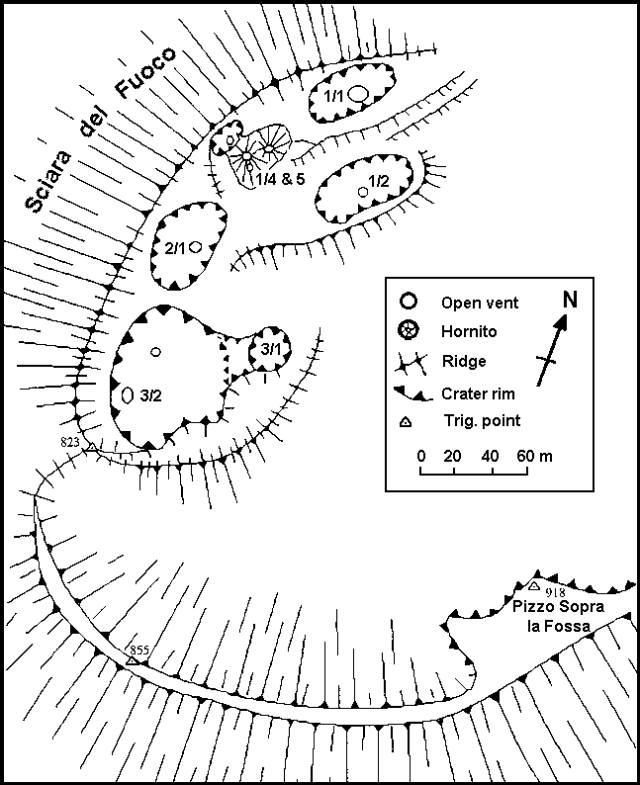Report on Stromboli (Italy) — December 1995
Bulletin of the Global Volcanism Network, vol. 20, no. 11 (December 1995)
Managing Editor: Richard Wunderman.
Stromboli (Italy) Low-level ash plumes and lava fountains during September-October
Please cite this report as:
Global Volcanism Program, 1995. Report on Stromboli (Italy) (Wunderman, R., ed.). Bulletin of the Global Volcanism Network, 20:11. Smithsonian Institution. https://doi.org/10.5479/si.GVP.BGVN199512-211040
Stromboli
Italy
38.789°N, 15.213°E; summit elev. 924 m
All times are local (unless otherwise noted)
In contrast to very intense activity seen in summer-autumn 1994, Boris Behncke noted that activity remained low from early 1995 through October. The low level of activity, also shown by seismic data acquired by the University of Udine (see recent Bulletins), was interpreted by some researchers as a possible precursor of a more powerful eruption in the near future, resulting in a warning and access restrictions in April-May.
Eruptions during August-October produced low lava fountains and ash plumes. Activity from vent 3/1 (figure 46) consisted of night glow and spatter ejections, at times throwing bombs outside the crater. Vent 1/1 had periods of vigorous lava fountaining, often dropping incandescent bombs on the Sciara del Fuoco, particularly in early September. During dry weather, a dense gas plume often formed a hazy layer at 850-900 m altitude that extended for tens of kilometers.
During a 19-20 September visit by Andy Harris and Nicki Stevens, activity was observed from five vents (figure 47). A 4-m-diameter vent in the side of a hornito (1/4), had incandescent walls and an internal temperature of 940°C, as measured with a Minolta/Land Cyclops 152 infrared (0.8-1.1 µm) thermometer. Gas-jet eruptions from this vent sent incandescent gas and minor ejecta ~50 m high. Regular explosions from vents 1/2 and 3/2 ejected bombs and brown ash clouds up to ~100 m. Seven eruptions during a 90-minute period from vent 2/1 sent bombs to a height of ~50 m. No explosions were seen from vent 3/1, but it exhibited continuous night glow and apparently quietly ejected a few bombs to no more than 10 m above the crater rim.
Observations by Behncke on 28-29 September showed that craters 2 and 3 had not changed significantly since a visit on 20 April (BGVN 20:04). Vent 3/1 showed fluctuating glow at night but had no ejections. Vent 3/2 had very weak emissions of reddish ash every 5-20 minutes. Crater 1 had been largely filled with small spatter cones during the summer of 1994, but their destruction began with a powerful phreatic explosion on 5 March 1995 (BGVN 20:04). However, the twin cones (1/4 & 5) in vent area 1/3 remained. Neither of them had erupted after September/October 1994, but an incandescent vent (~10 m wide) at the SE base of the SW cone (1/4) had brief noisy gas explosions that emitted a diffuse incandescent gas cloud.
Vigorous eruptions observed by Behncke from vent 1/1 ejected black ash plumes that occasionally rose >100 m. After dark, incandescent ejections were seen, and loud roaring noises were audible. Reports by other observers in early October disclosed continuing low-level eruptions from vents 1/1 and 3/2 and incandescence from vents 1/3 and 3/1. In addition to the vents active in September, a vent behind the twin cones in Crater 1 and a vent in the NW part of Crater 3 were active when observed by Open University geologists on 15 and 30 October.
Geological Summary. Spectacular incandescent nighttime explosions at Stromboli have long attracted visitors to the "Lighthouse of the Mediterranean" in the NE Aeolian Islands. This volcano has lent its name to the frequent mild explosive activity that has characterized its eruptions throughout much of historical time. The small island is the emergent summit of a volcano that grew in two main eruptive cycles, the last of which formed the western portion of the island. The Neostromboli eruptive period took place between about 13,000 and 5,000 years ago. The active summit vents are located at the head of the Sciara del Fuoco, a prominent scarp that formed about 5,000 years ago due to a series of slope failures which extends to below sea level. The modern volcano has been constructed within this scarp, which funnels pyroclastic ejecta and lava flows to the NW. Essentially continuous mild Strombolian explosions, sometimes accompanied by lava flows, have been recorded for more than a millennium.
Information Contacts: Boris Behncke and Giada Giuntoli, Department of Volcanology and Petrology, GEOMAR, Wischhofstr. 1-3, 24148 Kiel, Germany; Andy Harris, Department of Earth Sciences, The Open University, Milton Keynes MK7 6AA, United Kingdom; Nicki Stevens, ESSC, University of Reading, P.O. Box 227, Reading RG2 2AB, United Kingdom.


